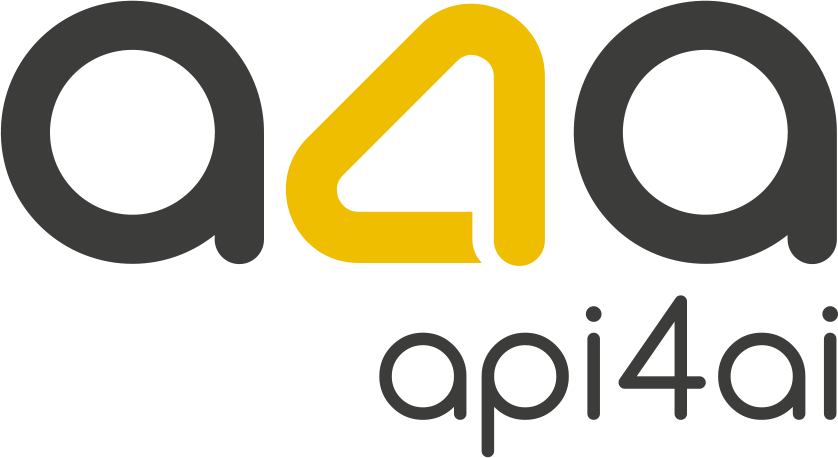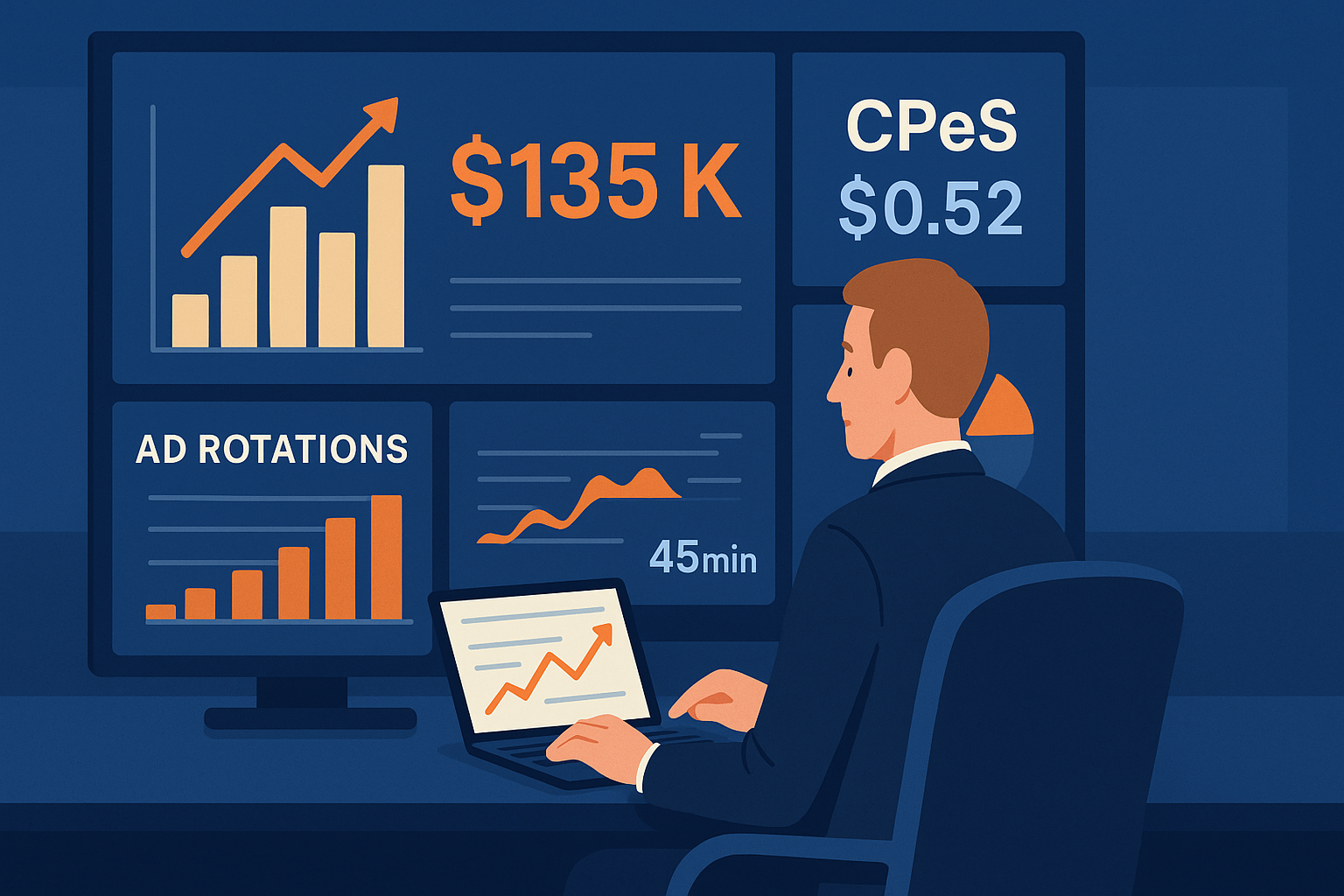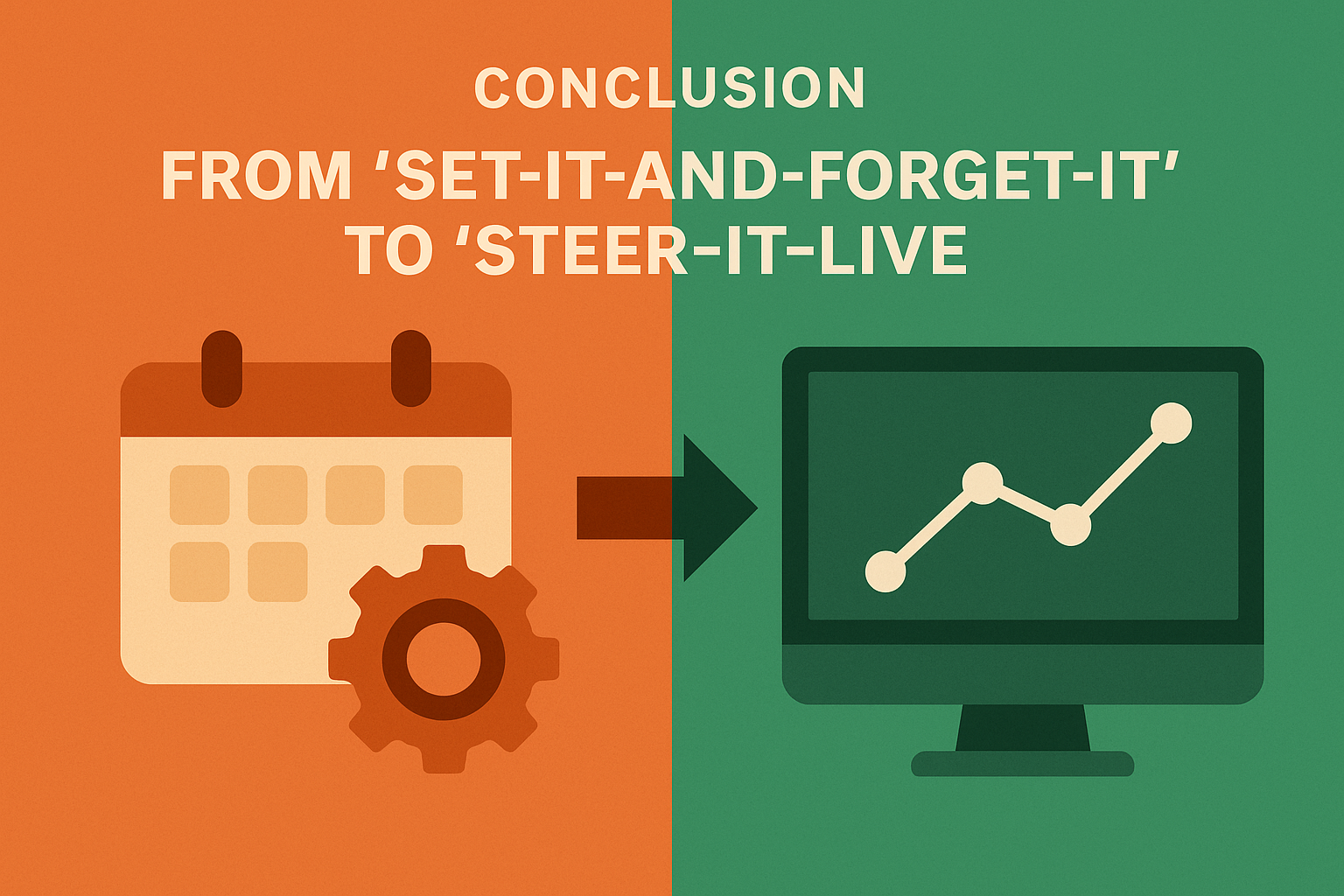Dynamic CPeS Calculator for Real-Time Ad Rotations
Introduction — From Static Boards to Programmatic LED Walls
A decade ago, perimeter boards were little more than illuminated billboards — one creative per advertiser, locked for the entire match. Today, those same LED ribbons behave like programmatic ad slots on a website: the creative can refresh every 60-90 seconds, or even faster when context justifies it. Stadium operators no longer sell “board ownership” for 90 minutes; they sell seconds of verified screen time, priced dynamically and audited in real-time.
Two technology breakthroughs made this leap possible. First, high-brightness, TV-grade LED systems now ship with native rotation schedulers, allowing multiple high-resolution creatives to cycle without perceptible lag or flicker (eagerled.com). Second, the live-video tech stack has caught up: addressable ad insertion platforms demonstrated sub-5-second end-to-end latency in 2025, proving that dynamic swaps won’t break the broadcast feed or the fan experience (TV Tech).
For rights-holders and their C-suite, the commercial implications are direct:
Revenue ceiling expands — one physical board can now accommodate dozens of sponsors, each billed by the second rather than by the match.
Inventory becomes fluid — unsold seconds can be programmatically filled in-game, turning dead airtime into opportunistic revenue.
Contract fulfilment goes granular — promised screen-time quotas are tracked frame-by-frame, minimising make-good obligations and strengthening sponsor trust.
Yet with greater flexibility comes greater operational complexity. Executives need a single, real-time metric that translates raw exposure into clear monetary value — Cost-per-Exposure Second (CPeS). When CPeS streams live alongside camera feeds, commercial teams can throttle or accelerate creative rotations on the fly, optimising yield without jeopardising contractual promises.
The remainder of this post breaks down why CPeS is emerging as the gold standard for dynamic stadium advertising, how a live calculator can be built on modern computer-vision APIs, and what strategic choices executives face when moving from static boards to adaptive revenue engines.
Why Mid-Match Creative Rotation Is Now Table-Stakes
Attention is a scarce currency
Sports broadcasts used to tolerate a single banner for an entire half. Not anymore. Eye-tracking studies show that visual fatigue sets in after roughly 40–60 seconds of viewing the same creative; a fresh image effectively “resets” attention, lifting recall scores on the next exposure. Dynamic boards exploit that reset, letting sponsors pay only for the seconds when fans and cameras are genuinely looking. Stadiums that rotate creatives every minute have reported double-digit lifts in brand recall compared with static banners (reissdisplay).
Sponsors are voting with their wallets
Digital-out-of-home (DOOH) spend is expanding at a healthy clip — analysts forecast a 12 %+ CAGR through 2034, driven largely by advertisers shifting budgets toward measurable, context-aware inventory such as stadium LEDs (EIN Presswire). Brand managers increasingly write contracts in “seconds of verified exposure,” not flat match fees, and expect the same flexibility they enjoy in programmatic online buys. If a perimeter board can’t rotate dynamically — or prove the value of each second — it risks being left off the media plan.
Technology has removed the last excuses
High-brightness, broadcast-grade LED panels now ship with refresh rates above 3 840 Hz, eliminating camera flicker and allowing near-instant creative swaps. SV Solutions On the software side, addressable-ad platforms demonstrated sub-5-second end-to-end latency in 2025, proving that mid-match swaps can happen without disrupting the live feed or alienating fans (TV Tech).
For C-level leaders, these dynamics converge into a simple imperative: if your boards can’t rotate in real time, you’re leaving inventory — and credibility — on the table. The next sections explain how Cost-per-Exposure Second (CPeS) turns this new flexibility into an executive-grade revenue lever.
The Metric That Turns Seconds into Revenue: Cost-per-Exposure Second (CPeS)
What it is
Cost-per-Exposure Second measures the actual on-screen seconds a brand receives, weighted by quality factors such as logo size, screen position and visual clarity, then divided by the price paid. In other words, it expresses “How many dollars did we earn (or spend) for every verified second the brand was visibly front-and-centre?” By tying value to audited visibility rather than to impressions or fixed packages, CPeS moves sponsorship from a faith-based buy to a performance-priced asset (Medium).
Why legacy metrics fall short
Traditional CPM or “package fee per match” models assume every camera angle and every viewer minute is equal — an assumption today’s sponsors reject. Research by Kantar shows that attention, and therefore brand impact, fluctuates dramatically across contexts and seconds. If attention changes second-by-second, so should pricing. CPeS delivers that granularity while remaining simple enough for a CFO to reconcile on the balance sheet.
The real-time leap
Historically, even sophisticated sponsorship audits arrived days after the final whistle — too late to fix quota shortfalls or capture unexpected demand. With computer-vision APIs feeding logo detections and size data into a live calculator, CPeS can update every second. Commercial teams now see a ticker of revenue efficiency and can:
Throttle creative rotation when CPeS falls below a floor, squeezing more value from high-attention moments.
Accelerate under-served sponsors before contractual penalties loom.
Offer pop-up inventory to brands monitoring the same feed in their command centres.
Governance baked in
Because each second is verified algorithmically — logo detected, bounding box measured, clarity scored — auditors receive a tamper-proof log of exposure that satisfies both brand compliance officers and rights-holder finance teams. If the numbers don’t match the contract, you know why and where in the footage, instantly.
Strategic payoff for the C-suite
Pricing confidence: move from negotiated discounts to data-defended premiums.
Operational agility: treat LED inventory like programmatic display, redeploying seconds mid-match to maximise yield.
Sponsor trust: deliver transparent proof-of-performance that beats end-of-season make-good debates.
In the next section we lift the hood on the six-layer architecture that powers a live CPeS feed — starting with the computer-vision APIs that transform raw pixels into revenue-ready data.
Inside the Live CPeS Calculator — A Six-Layer Architecture
Building a real-time Cost-per-Exposure Second feed is less about moon-shot R&D and more about orchestrating proven components. Below is the reference stack that leading rights-holders deploy; each layer can be bought off the shelf, stitched together via REST or message bus, and scaled from a single test board to an entire league.
1. Ultra-Low-Latency Video Ingest
Multiple camera feeds — broadcast, tactical, in-stadium — are captured and transcoded in <200 ms, preserving frame accuracy for downstream analytics. Vendors such as Yospace recently demonstrated sub-5-second end-to-end addressable-ad latency, proving the pipeline is production-ready for live sport.
2. Computer-Vision Detection Layer
This is where pixels turn into data. A cloud logo-detection endpoint (e.g., the Brand Recognition API) identifies and sizes thousands of marks without retraining. When needed, OCR and generic object-detection APIs plug into the same frame buffer to capture sponsor slogans, product shots or compliance red flags. The pay-as-you-go model means you pay only for analysed frames, not idle servers.
3. Exposure-Scoring Engine
Raw detections hit a rules engine that weights each appearance by size, on-screen position and clarity. A centre-circle hit at full HD resolution might earn a 1.8× multiplier, while a narrow-angle sideline cameo gets a 0.6× weight. These coefficients are fully configurable, letting sponsorship teams align the math with contractual definitions of “quality exposure.”
4. Financial Overlay & Quota Tracker
The engine fuses exposure scores with rate cards, seasonal discounts and minimum-guarantee clauses to compute live CPeS for every brand. Alerts fire if a sponsor drifts off-pace (risking make-goods) or if exposure value spikes above a predefined ceiling — prime time to insert premium spots.
5. Streaming Analytics API
Processed metrics publish to a lightweight WebSocket or gRPC stream that BI dashboards, trading desks or even sponsor-side war rooms can subscribe to. Executives view a ticker of live CPeS, quota progress and projected end-of-match delivery — no wait for overnight logs.
6. Rotation Control Hooks
Finally, the same stream feeds back into the LED controller’s scheduling API. If CPeS dips below target, the scheduler throttles creative rotations to harvest higher-value seconds; if a brand nears its quota, rotations ease to avoid over-delivery. Modern LED systems ship with 3 840 Hz refresh rates, so swaps occur without broadcast flicker (bibiled.com).
Result: an adaptive revenue engine
By decoupling detection, scoring and financial logic into modular layers, rights-holders gain the agility of programmatic digital — without rebuilding their entire tech stack. Each piece can be phased in: start with detection + scoring for audit clarity, bolt on the streaming API for real-time visibility, then close the loop with automated rotation when governance teams are comfortable.
In the next section, we’ll look at the practical playbooks your commercial staff can run once this architecture is live — from squeezing upside during high-attention moments to safeguarding contractual promises when the match doesn’t go to plan.
Revenue Control-Room Playbook — Turning Data into Dollars
Real-time Cost-per-Exposure Second (CPeS) gives commercial teams the same levers a programmatic trader enjoys — only this time the “placements” are LED boards inside a packed stadium. Below are the three most common control-room manoeuvres executives now run once a live CPeS feed is on their dashboard.
1. Capitalise on Demand Spikes
Situation — A derby match enters a nail-biting extra-time period; broadcast cameras linger on the centre-circle LED ribbon. Average CPeS suddenly drops below your target floor because every second of exposure is undervalued relative to the surge in attention.
Move — The scheduler accelerates creative swaps (e.g., from every 90 s to every 45 s) for premium categories willing to pay surge pricing. Stadiums that have implemented this tactic during high-interest windows report double-digit revenue uplifts compared with fixed rotations (Nevco).
2. Rescue At-Risk Quotas Before the Final Whistle
Situation — A beverage sponsor is contractually guaranteed 2 minutes of clear exposure per half. With ten minutes left, the live quota tracker shows only 1 min 15 s delivered; over-time looks unlikely.
Move — The engine allocates priority slots exclusively to that sponsor until the quota is met, then reverts to normal pacing. By intervening in-match rather than post-match, rights-holders avoid make-good obligations and preserve margin.
3. Balance Competing Brands Without Manual Micromanagement
Situation — Two telecom brands share category rights. One is over-exposed, the other lagging. A manual fix risks human error and contractual breaches.
Move — Rotation logic applies real-time weighting: Brand A’s creative frequency is throttled; Brand B receives incremental seconds until share-of-voice parity is restored. Advanced setups also run NSFW or compliance checks via image-based moderation APIs to ensure no creative slips through that violates venue policies.
Governance & Risk Controls Built In
Data-sharing audit trail — Every second of exposure is logged and time-stamped, creating a tamper-proof evidentiary record that satisfies sponsor finance teams and external auditors. Recent guidance emphasises embedding data-rights clauses in all sponsorship contracts to maximise joint value and minimise disputes (morganlewis.com).
Automatic conflict detection — The same computer-vision layer that feeds CPeS can flag exclusivity clashes (e.g., a rival beer logo during a “category exclusive” minute) or inappropriate content before it hits the screen, avoiding potential fines and reputational damage.
Real-time alerts for C-suite — Threshold breaches — whether falling below target CPeS or overrunning a quota — trigger push notifications to an executive mobile app, allowing decision-makers to override or approve automated adjustments instantly.
Outcome for the Boardroom
Revenue lifts, contractual confidence, and brand trust now depend less on perfect pre-match planning and more on in-match optimisation. With a live CPeS feed and these playbooks in place, every second of LED inventory becomes an actively managed asset — one that can respond to the unpredictable ebb and flow of the game while still hitting the precise promises that underpin modern sponsorship deals.
Build, Buy or Blend — Choosing the Right Path to a Live CPeS Engine
C-level leaders face a familiar strategic fork: move fast with ready-made cloud services, invest in a fully bespoke platform, or blend the two. Each route carries distinct implications for capital outlay, speed-to-market, and long-term competitive edge.
Buy (API-First) — Speed Wins the Pilot Race
Turning on a logo-detection endpoint, an OCR module, and a quota tracker via cloud APIs is the quickest way to launch a proof-of-concept. Reports tracking enterprise AI deployments show that subscription prices often begin at a few hundred dollars per month — a rounding error compared with the six-figure payroll for even a small in-house data-science team.
Pros: weeks-not-months deployment, minimal CapEx, usage-based cost scaling, vendor-managed upgrades.
Cons: feature road-map controlled by the provider; limited ability to bake in proprietary metrics that differentiate your inventory.
Build — Full Control, Full Responsibility
Owning the entire stack — from model training to rotation logic—can unlock bespoke exposure formulas no competitor can copy. Yet studies warn that initial build budgets of $100 k–$500 k are only the tip of the iceberg once maintenance, compliance and talent retention are factored in (Robovision).
Pros: tailor-made algorithms, on-prem deployment for low-latency venues, potential IP valuation upside.
Cons: 12-to-18-month lead times, scarce computer-vision talent, recurring MLOps overhead that can dwarf year-one costs.
Blend — The Pragmatic Middle Ground
Most rights-holders now blend off-the-shelf computer-vision APIs with a thin custom layer for sport-specific scoring, financial logic, and board-rotation rules. Gartner calls this “built-and-blended AI,” noting it keeps strategic control in-house while outsourcing commodity detection tasks (Gartner).
Pros: 80 % of heavy lifting handled by mature APIs; custom code focuses on revenue-driving differentiation; migration path to full ownership remains open.
Cons: Requires careful API orchestration and robust data-governance practice to avoid vendor lock-in.
Decision Checklist for the Board
Time-to-Revenue — Can you afford to wait a season, or is there pressure to monetise the next televised match?
Regulatory & Data Policies — Will sponsor audits or regional data-sovereignty laws mandate on-prem processing?
Competitive Moat — Does a proprietary exposure algorithm materially improve negotiating power with blue-chip brands?
Lifecycle Economics — Compare five-year total cost of ownership, not just year-one CapEx vs subscription fees.
Change Management — Assess whether commercial, IT and venue-ops teams can absorb a new workflow at API speed, or if phased enablement is wiser.
Executive takeaway: Begin with an API-first pilot — two cameras, one LED board, live CPeS ticker. Validate revenue lift in weeks. If the upside justifies deeper customisation, layer in proprietary scoring, on-prem inference, or even full model ownership. The “buy-then-blend” path preserves agility today while positioning the organisation for differentiated capabilities tomorrow.
Conclusion — From Reactive Booking to Real-Time Yield
The numbers are unequivocal: digital-out-of-home will account for more than 40 % of all OOH revenue by 2025, fuelled by programmatic buying and LED upgrades in high-profile venues (The Current). As this cash tide rolls in, perimeter boards that still rely on fixed creative schedules will be priced — and perceived — like yesterday’s static billboards. A live Cost-per-Exposure Second (CPeS) feed flips that script, letting rights-holders treat every second of visibility as inventory to be traded, throttled or banked according to demand.
Executives now have a practical playbook: launch an API-first pilot on a single board, measure CPeS lift over one televised matchday, then layer in bespoke business logic if the upside warrants deeper investment. Organisations that took this “buy-then-blend” path in 2024 reported double-digit sponsorship-revenue gains within the same season, while slashing make-good penalties to near zero (Forbes).
Looking ahead, the frontier is predictive CPeS — models that forecast exposure value 30 seconds before the camera cuts, enabling pre-emptive creative swaps and auction-style pricing. Analysts expect the wider sports-analytics market to quintuple by 2032, underscoring how data-driven monetisation is becoming a decisive competitive lever for clubs, leagues and venue operators alike (Fortune Business Insights).
The call to action is clear: start small, start now. Every match played without a real-time CPeS engine is potential revenue — and strategic insight — left on the pitch.






